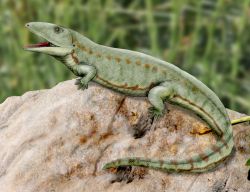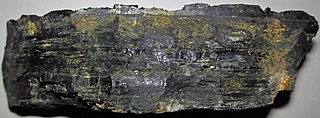
Eryops is a genus of extinct, amphibious temnospondyls. It contains the single species Eryops megacephalus, the fossils of which are found mainly in early Permian rocks of the Texas Red Beds, located in Archer County, Texas. Fossils have also been found in late Carboniferous period rocks from New Mexico. Several complete skeletons of Eryops have been found in lower Permian rocks, but skull bones and teeth are its most common fossils.

"Labyrinthodontia" is an informal grouping of extinct predatory amphibians which were major components of ecosystems in the late Paleozoic and early Mesozoic eras. Traditionally considered a subclass of the class Amphibia, modern classification systems recognize that labyrinthodonts are not a formal natural group (clade) exclusive of other tetrapods. Instead, they consistute an evolutionary grade, ancestral to living tetrapods such as lissamphibians and amniotes. "Labyrinthodont"-grade vertebrates evolved from lobe-finned fishes in the Devonian, though a formal boundary between fish and amphibian is difficult to define at this point in time.

Lepospondyli is a diverse taxon of early tetrapods. With the exception of one late-surviving lepospondyl from the Late Permian of Morocco, lepospondyls lived from the Early Carboniferous (Mississippian) to the Early Permian and were geographically restricted to what is now Europe and North America. Five major groups of lepospondyls are known: Adelospondyli; Aïstopoda; Lysorophia; Microsauria; and Nectridea. Lepospondyls have a diverse range of body forms and include species with newt-like, eel- or snake-like, and lizard-like forms. Various species were aquatic, semiaquatic, or terrestrial. None were large, and they are assumed to have lived in specialized ecological niches not taken by the more numerous temnospondyl amphibians that coexisted with them in the Paleozoic. Lepospondyli was named in 1888 by Karl Alfred von Zittel, who coined the name to include some tetrapods from the Paleozoic that shared some specific characteristics in the notochord and teeth. Lepospondyls have sometimes been considered to be either related or ancestral to modern amphibians or to Amniota. It has been suggested that the grouping is polyphyletic, with aïstopods being primitive stem-tetrapods, while recumbirostran microsaurs are primitive reptiles.
Lysorophia is an order of fossorial Carboniferous and Permian tetrapods within the Recumbirostra. Lysorophians resembled small snakes, as their bodies are extremely elongate. There is a single family, the Molgophidae. Currently there are around five genera included within Lysorophia, although many may not be valid.

Adelospondyli is an order of elongated, presumably aquatic, Carboniferous amphibians. They have a robust skull roofed with solid bone, and orbits located towards the front of the skull. The limbs were almost certainly absent, although some historical sources reported them to be present. Despite the likely absence of limbs, adelospondyls retained a large part of the bony shoulder girdle. Adelospondyls have been assigned to a variety of groups in the past. They have traditionally been seen as members of the subclass Lepospondyli, related to other unusual early tetrapods such as "microsaurs", "nectrideans", and aïstopods. Analyses such as Ruta & Coates (2007) have offered an alternate classification scheme, arguing that adelospondyls were actually far removed from other lepospondyls, instead being stem-tetrapod stegocephalians closely related to the family Colosteidae.

Ophiacodon is an extinct genus of synapsid belonging to the family Ophiacodontidae that lived from the Late Carboniferous to the Early Permian in North America and Europe. The genus was named along with its type species O. mirus by paleontologist Othniel Charles Marsh in 1878 and currently includes five other species. As an ophiacodontid, Ophiacodon is one of the most basal synapsids and is close to the evolutionary line leading to mammals.

Ctenospondylus is an extinct genus of sphenacodontid synapsid

Platyhystrix is an extinct temnospondyl amphibian with a distinctive sail along its back, similar to the unrelated synapsids, Dimetrodon and Edaphosaurus. It lived during the boundary between the latest Carboniferous and earliest Permian periods throughout what is now known as the Four Corners, Texas, and Kansas about 300 million years ago.

Microsauria is an extinct, possibly polyphyletic order of tetrapods from the late Carboniferous and early Permian periods. It is the most diverse and species-rich group of lepospondyls. Recently, Microsauria has been considered paraphyletic, as several other non-microsaur lepospondyl groups such as Lysorophia seem to be nested in it. Microsauria is now commonly used as a collective term for the grade of lepospondyls that were originally classified as members of Microsauria.

Embolomeri is an order of tetrapods or stem-tetrapods, possibly members of Reptiliomorpha. Embolomeres first evolved in the Early Carboniferous (Mississippian) Period and were the largest and most successful predatory tetrapods of the Late Carboniferous (Pennsylvanian) Period. They were specialized semiaquatic predators with long bodies for eel-like undulatory swimming. Embolomeres are characterized by their vertebral centra, which are formed by two cylindrical segments, the pleurocentrum at the rear and intercentrum at the front. These segments are equal in size. Most other tetrapods have pleurocentra and intercentra which are drastically different in size and shape.

Anthracosaurus is an extinct genus of embolomere, a possible distant relative of reptiles that lived during the Late Carboniferous in what is now Scotland, England, and Ohio. It was a large, aquatic eel-like predator. It has a robust skull about 40 centimetres (1.3 ft) in length with large teeth in the jaws and on the roof of the mouth. Anthracosaurus probably inhabited swamps, rivers and lakes. Its name is Greek for "coal lizard".

Protorothyris is an extinct genus of Early Permian protorothyridid known from Texas and West Virginia of the United States. It was first named by Llewellyn Ivor Price in 1937 and the type species is Protorothyris archeri. P. archeri is known from the holotype MCZ 1532, a three-dimensionally preserved skull and from the referred specimens, which come from four additional individuals, MCZ 2147-2150. All specimens were collected in the Cottonwood Creek site, from the Archer City Formation, Texas, dating to the Asselian stage of the Cisuralian epoch, about 299–294.6 million years ago. A second species, P. morani, was first named by Alfred Sherwood Romer in 1952 with its own generic name, Melanothyris. In 1973, J. Clark and Robert L. Carroll recombined P. morani as a Protorothyris species. It is known from the holotype CM 8617, a three-dimensionally preserved skull. It was collected in the Blacksville site, from the Washington Formation of West Virginia. Protorothyris was the size of the average lizard, about 30 cm in length.

The Allegheny Group, often termed the Allegheny Formation, is a Pennsylvanian-age geological unit in the Appalachian Plateau. It is a major coal-bearing unit in the eastern United States, extending through western and central Pennsylvania, western Maryland and West Virginia, and southeastern Ohio. Fossils of fishes such as Bandringa are known from the Kittaning Formation, which is part of the Allegheny Group.

Neopteroplax is an extinct genus of eogyrinid embolomere closely related to European genera such as Eogyrinus and Pteroplax. Members of this genus were among the largest embolomeres in North America. Neopteroplax is primarily known from a large skull found in Ohio, although fragmentary embolomere fossils from Texas and New Mexico have also been tentatively referred to the genus. Despite its similarities to specific European embolomeres, it can be distinguished from them due to a small number of skull and jaw features, most notably a lower surangular at the upper rear portion of the lower jaw.

Acroplous is an extinct genus of dvinosaurian Temnospondyli within the family Eobrachyopidae.

Acherontiscus is an extinct genus of stegocephalians that lived in the Early Carboniferous of Scotland. The type and only species is Acherontiscus caledoniae, named by paleontologist Robert Carroll in 1969. Members of this genus have an unusual combination of features which makes their placement within amphibian-grade tetrapods uncertain. They possess multi-bone vertebrae similar to those of embolomeres, but also a skull similar to lepospondyls. The only known specimen of Acherontiscus possessed an elongated body similar to that of a snake or eel. No limbs were preserved, and evidence for their presence in close relatives of Acherontiscus is dubious at best. Phylogenetic analyses created by Marcello Ruta and other paleontologists in the 2000s indicate that Acherontiscus is part of Adelospondyli, closely related to other snake-like animals such as Adelogyrinus and Dolichopareias. Adelospondyls are traditionally placed within the group Lepospondyli due to their fused vertebrae. Some analyses published since 2007 have argued that adelospondyls such as Acherontiscus may not actually be lepospondyls, instead being close relatives or members of the family Colosteidae. This would indicate that they evolved prior to the split between the tetrapod lineage that leads to reptiles (Reptiliomorpha) and the one that leads to modern amphibians (Batrachomorpha). Members of this genus were probably aquatic animals that were able to swim using snake-like movements.

Adamanterpeton is a genus of Edopoid Temnospondyl within the family Cochleosauridae. The type species A. ohioensis was named in 1998 and is currently the only known species within this genus. Adamanterpeton is rare in the Linton vertebrate assemblage, with other amphibians like Sauropleura, Ophiderpeton, and Colosteus being more common. Unlike other Linton vertebrates, Adamanterpeton may have been adapted to a terrestrial lifestyle.

Recumbirostra is a clade of tetrapods which lived during the Carboniferous and Permian periods. They are thought to have had a fossorial (burrowing) lifestyle and the group includes both short-bodied and long-bodied snake-like forms. At least one species, the long-bodied molgophid Nagini mazonense, lost its forelimbs entirely. Recumbirostra includes the families Pantylidae, Gymnarthridae, Ostodolepidae, Rhynchonkidae and Brachystelechidae, with additional families such as Microbrachidae and Molgophidae being included by some authors. Brachystelechidae and Molgophidae have also been grouped together in the suggested clade Chthonosauria.

The Washington Formation is a coal, sandstone, and limestone geologic formation located in Ohio, Pennsylvania and West Virginia. It dates back to the Lower Permian period, with its base at or near the Permian/Carboniferous boundary. The Washington formation and the Dunkard Group as a whole was deposited at a time when the continents were in the process of forming the "Super Continent" Pangaea as well as a gradual drop in sea levels. The result during this period was coals being thinner and impure with high ash content. The limestones found with in the formation are exclusively freshwater deposits.
Eobaphetes is an extinct genus of embolomere which likely lived in the Pennsylvanian of Kansas. The genus is based on several skull and jaw fragments of a single individual. They were originally described under the species Erpetosuchus kansasensis, but this was later changed to Eobaphetes kansasensis when it was determined that Erpetosuchus was preoccupied by a Triassic reptile.




















